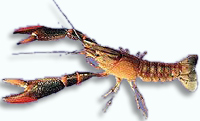Rationale for
Investment
- Production technology
available.
- High profitability.
- Huge international
markets.
- Significant potential for
growth.
Commercial and Technical
Merits
- Redclaw is excellent for aquaculture due
to its physical, biological and commercial attributes.
- Robust species with broad geographic
potential & simple life cycle.
- Production technology uncomplicated,
viable & proven.
- Simple feeds.
- Relatively economical to produce.
- Looks like a lobster and
good eating qualities, premium end of the crustacean market
spectrum.
- A$12 to 19/kg
farm-gate price depending on size.
- Sold as live product, cooked or frozen.
Keys to Commercial Success
- Climate
and geography.
- Selection of strains with
high fecundity and fast growth rates.
- Pond size, shape, design
and water quality, temperature, recycling. and
effluent management.
- Superior brood stock and
establishment of a system for producing juveniles for stocking.
- Shelter and feed
for
juvenile production and grow-out stock.
- Selection of harvesting techniques.
- Postharvest management techniques &
processing technology.
- Marketing and
transportation know-how.
- Consumer awareness and product standards.
- Quality, quantity and consistency of
supply.
- Produce redclaw
with attributes according to consumer and
market requirements.
|
Profitability Analysis
Australian operations |
|
Assumptions |
|
□ |
Pond area of 4.7 hectares: 7 juvenile + 40 grow-out ponds.
This represents the minimum pond area for commercial viability. |
|
□ |
20 year project life. |
|
□ |
Annual harvest 394 kg/grow-out pond from Year 2 onwards. |
|
□ |
Average growing time 9 months to 65 g mean weight which fetches A$14/kg
at farm gate. |
|
□ |
Farm establishment cost = A$347,900 (land, labor, machinery,
farm infrastructure). |
|
□ |
Average farm profit A$5.25/kg/year. |
|
□ |
Total production costs = A$8.25/kg each year (all operating costs,
capital costs, & allowance for owner's labor and management). |
|
Analysis |
|
□ |
Discounted Payback Period = 4 years (to recover initial outlay). |
|
□ |
At an annual yield of 394 kg/grow-out pond
the minimum price for the investment to be profitable was
A$8.25/kg. |
|
□ |
Conversely, at an assumed price of A$13.50/kg,
the minimum yield for profitability was 232
kg/grow-out pond. |
|
□ |
Grow-out
periods vary between 6 to 15 months depending
on weight desired for marketing. Analysis
of the interaction between prices, survival rates and market
weights showed that the most profitable option was a grow-out period of
9 months. |
|
□ |
Indicated gross profit
is:
$2,500 X 40 = A$100,000/year
from Year 2. |
|
|
Source:
Rural Industries Research &
Development Corporation (1997) |
|


 If you are interested in this project please
follow this link.
If you are interested in this project please
follow this link.